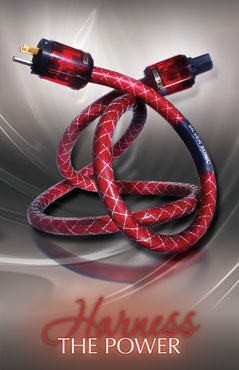DH Labs Red Wave AC Cord
|
|
|
Another Take |
|
|
|
April 2012 |

After reading Frank Alles’ thoughtful and thorough piece on DH Labs’ complete “loom” of cables back in February (here), I thought I’d chime in on the DH cable he liked least: the Red Wave AC Cord.
I’ve had the Red Wave in my system for a couple of years, and while I don’t believe it’s the greatest power cord in existence, I do believe it’s substantially ahead of any PC I’ve heard under $1,000 – and I’ve heard a bunch.
My Red Wave purchase was an impulse buy. I was looking for that last bit of fine tuning in an already good system. I had not heard any of DH Labs products, so I had no expectations, either positive or negative, for the Red Wave.
First impressions even before plugging it in: This thing is substantial, with a build quality and feel that embarrass a number of competing products. The Red Wave should easily outlive most of us. It’s 10-gauge, silver-plated copper on the inside (BTW, it’s a shielded cable), and a really cool red jacket – no cheap mesh here – on the outside.  The Red Wave’s first assignment was the input of a transformer-based power conditioner. Right away, the difference at the low-end made me sit up and take notice. On “The Empire Strikes Back,” from Telarc’s classic CD Star Tracks, the bass detail was noticeably clearer, with both the initial impact and the decay of the bass drum containing much more than just “boom”: the vibration of the drum skin after each strike gave me an increased feeling of being at the session.
The Red Wave’s first assignment was the input of a transformer-based power conditioner. Right away, the difference at the low-end made me sit up and take notice. On “The Empire Strikes Back,” from Telarc’s classic CD Star Tracks, the bass detail was noticeably clearer, with both the initial impact and the decay of the bass drum containing much more than just “boom”: the vibration of the drum skin after each strike gave me an increased feeling of being at the session.
Frank noticed increased brightness in his system with the addition of the Red Waves. To me, brightness implies an increase in the level or proportion of lower treble. In my system, I would characterize the change in balance as akin to moving from Row M to Row J in a concert hall, i.e. a slightly more upfront sound at all frequencies, accompanied by a welcome increase in detail. But the detail was not forced, or accompanied by an increase in brightness. The Radialstrahler tweeters in my MBL speakers are especially sensitive to brightness and glare, and they didn’t complain with the Red Wave’s insertion. Listen  to the violins in Dvorak’s Symphony #7 (Dorati, Mercury Living Presence CD): they are lively-sounding, as are the strings on most Mercury CD’s. But they do not cross over to irritation or brightness.
to the violins in Dvorak’s Symphony #7 (Dorati, Mercury Living Presence CD): they are lively-sounding, as are the strings on most Mercury CD’s. But they do not cross over to irritation or brightness.
The qualities of the Red Wave were consistent on other electronics: the Linn Unidisk, and the Classe solid-state electronics in my system. And while the Red Waves don’t have the sheer impact of, say, the JPS Aluminata PC ($3995 – read Don Shaulis’ review here), or the gorgeous micro-detail of the Audio Magic Clairvoyant Liquid Air AC cable ($2000/1.5 meter – review to come), they’ve got more of these qualities than anything at or near their price point.
All of this is not to impugn or disagree with what Frank Alles heard in his system. It merely points up the need for auditioning in one’s own rig.
I like to mix and match the cables in my system, rather than sticking with anyone’s “house sound.” But the DH Labs Red Wave is the power cord I’d unhesitatingly recommend for any component or an entire system if the goal is high-end sound and build quality at a bargain price. My Red Wave has taken on all comers, and remains the preferred AC cord for my Classe CP-500 preamp.

dave allison
![]()
Don’t forget to bookmark us! (CTRL-SHFT-D)
Stereo Times Masthead
Publisher/Founder
Clement Perry
Editor
Dave Thomas
Senior Editors
Frank Alles, Mike Girardi, Russell Lichter, Terry London, Moreno Mitchell, Paul Szabady, Bill Wells, Mike Wright, and Stephen Yan,
Current Contributors
David Abramson, Tim Barrall, Dave Allison, Ron Cook, Lewis Dardick, John Hoffman, Dan Secula, Don Shaulis, Greg Simmons, Eric Teh, Greg Voth, Richard Willie, Ed Van Winkle, Rob Dockery, Richard Doran, and Daveed Turek
Site Management Clement Perry
Ad Designer: Martin Perry





Be the first to comment on: DH Labs Red Wave AC Cord